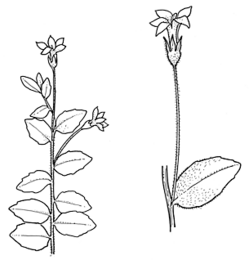Common name: Matted Pratia, Trailing Pratia
Lobelia pedunculata R.Br. APNI* Synonyms: Pratia puberula Benth. APNI*
Lobelia benthamii F.Muell. APNI*
Pratia pedunculata (R.Br.) Benth. APNI*

Description: Perennial herb, dioecious, branches ascending or prostrate and often mat-forming, hairy; rhizomatous, often with adventitious roots.
Leaves distichous, ± circular to ± ovate, usually 4–13 mm long, 3–7 mm wide, apex obtuse, base asymmetric and obtuse or subcordate, margins toothed; ± sessile.
Flowers unisexual, few, solitary; peduncles 15–50 mm long, pubescent. Calyx 1.5–2.5 mm long. Corolla 5–8 mm long, white or bluish mauve, lobes sometimes with a darker central line, tube pale; lobes linear-oblanceolate, spreading and nearly equal. Male flowers with purplish anthers, upper pair each with a slender bristle and with shorter hairs below; ovary rudimentary. Female flowers with pale sterile anthers; ovary 1–1.5 mm long.
Fruit fleshy, 4–10 mm long, 4–6 mm diam.
Flowering: mainly November–January
Distribution and occurrence: Grows in swampy places on damp ground, margins of rivers and lakes and in wet sclerophyll forest, chiefly on the ranges.
NSW subdivisions: NC, CC, SC, NT, CT, ST
Other Australian states: Vic. Tas. S.A.
Text by B. Wiecek
Taxon concept: Flora of NSW 3 (1992) as Pratia pedunculata
APNI* Provides a link to the Australian Plant Name Index (hosted by the Australian National Botanic Gardens) for comprehensive bibliographic data
***The AVH map option provides a detailed interactive Australia wide distribution map drawn from collections held by all major Australian herbaria participating in the Australian Virtual Herbarium project.
|


